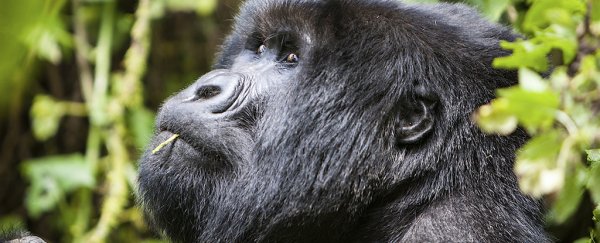The eastern gorilla is the largest living primate in the world, and it's now critically endangered and just one step away from extinction, researchers say.
Less than 5,000 are estimated to exist in the wild, with illegal hunting being the main reasons for the species' slide, the International Union for the Conservation of Nature (IUCN) reports. The species has just had its status changed from "endangered" to "critically endangered" on the updated Red List of Endangered Species.
According to the IUCN, numbers have dropped about 70 percent in the last two decades, and with ongoing political instability in the areas the eastern gorilla calls home, it's going to be difficult to reverse the fall.
"To see the eastern gorilla – one of our closest cousins – slide towards extinction is truly distressing," said IUCN director General Inger Andersen. "We live in a time of tremendous change and each IUCN Red List update makes us realise just how quickly the global extinction crisis is escalating."
It's a bleak picture for apes overall, with four out of the six great ape species – the eastern gorilla, western gorilla, Bornean orangutan, and Sumatran orangutan – all listed as critically endangered. This means the species face an extremely high risk of extinction in the wild in the immediate future.
That leaves the chimpanzee and the bonobo, which are both considered endangered, and are facing a very high risk of extinction in the wild in the near future.
Eastern gorillas are split up into two subspecies: Grauer's gorilla (or the eastern lowland gorilla), and the mountain gorilla (which you may know from Gorillas in the Mist). Around 880 mountain gorillas are believed to be alive today.
Most eastern gorillas are found in the Democratic Republic of Congo (DRC), but recent civil war, government corruption, and political uncertainty have all taken their toll on the country, and the gorillas living inside it.
Experts are hoping that if stability returns, an ecotourism industry might grow in the DRC – as it has in Uganda and Rwanda – and that would help keep gorilla numbers stable, reports CBS News.
While the prospects look grim, we can underpin our hopes with the recent conservation success of the giant panda: the IUCN has just downgraded the animals' threat of extinction from "endangered" to "vulnerable". Still not great, but a step in the right direction.
Giant panda numbers have risen by 17 percent over the last 10 years, and two-thirds of the population are now living in heavily protected reserves in China. Experts think that there are now around 2,000 giant pandas in the wild.
The IUCN says forest protection and reforestation measures have helped boost giant panda numbers, giving the animals more room to live and food to eat. For panda survival, both are sorely needed: a giant panda can eat up to up to 12.5 kilograms (or 27.5 pounds) of bamboo every day.
With the ravaging effects of climate change making conservation challenges harder all the time, it's going to take a huge amount of effort to save these endangered species – but it's definitely possible.
"Conservation action does work and we have increasing evidence of it," said Andersen. "It is our responsibility to enhance our efforts to turn the tide and protect the future of our planet."
